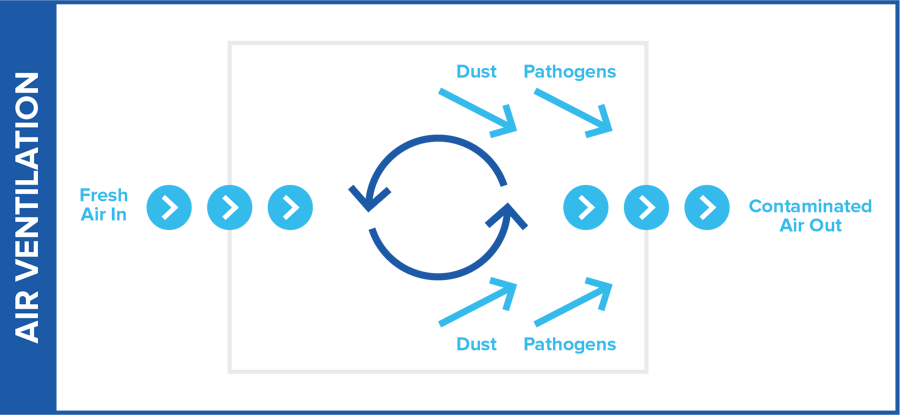 Indoor air quality (IAQ) is the air quality found in and around buildings, and the impact that it has on the health and comfort of those who live or work in said buildings. IAQ can include but is not limited to temperature, poor ventilation, humidity, mold, and exposure to chemicals. IAQ has been an important topic for a long time but only recently received the attention it deserves because of the COVID-19 pandemic. Let’s take a look at the causes of poor IAQ, why you should care about it, and what the negative consequences of it are.
Indoor air quality (IAQ) is the air quality found in and around buildings, and the impact that it has on the health and comfort of those who live or work in said buildings. IAQ can include but is not limited to temperature, poor ventilation, humidity, mold, and exposure to chemicals. IAQ has been an important topic for a long time but only recently received the attention it deserves because of the COVID-19 pandemic. Let’s take a look at the causes of poor IAQ, why you should care about it, and what the negative consequences of it are.
What Causes Poor Indoor Air Quality?
There are three main causes of poor IAQ. These are indoor pollution sources, temperature and humidity levels, and inadequate ventilation. One or all of these three causes of poor IAQ could be present in your facility right now, and you may not even be aware of it. Luckily, they should all be fairly easy to diagnose with the proper equipment and a little of your time.Indoor pollution can come from a wide variety of sources, but the first and often the biggest source of indoor pollution actually comes from the outdoors. The quality of the air inside your building or facility is directly affected by the quality of the air outside of it, because outdoor air gradually makes its way inside over time.
As the air from the outdoors comes inside, pollutants build up in the air that is already indoors, causing the IAQ to drop. These outdoor pollutants can include radon, pesticides, smog, and more.
Other Indoor Pollution Sources Include But Are Not Limited To:
- Tobacco products
- Any combustion appliance that burns fuel (i.e. a space heater)
- Stoves
- Ovens
- Fireplaces
- Building materials
- Household cleaning products
- HVAC systems
- Humidifiers
It is important to remember that the list above is not the only way pollution is created indoors. High temperature and humidity levels help to increase the concentrations of certain pollutants. For example, many bacteria and viruses thrive in high or low humidity conditions. Mold, meanwhile, prefers high humidity only. Additionally, pollutants like ozone and formaldehyde change concentrations as soon as there is a change in humidity.
Finally, inadequate ventilation in your building can cause pollutants to reach an even higher level of concentration given enough time. Proper air ventilation will remove dust and pathogens to help support high-quality air throughout your facility.

Why Should I Care About My Indoor Air Quality?
The biggest reason that you should make good IAQ a priority in your facility or building is because your staff is depending on good IAQ to help keep them healthy and comfortable. By providing this type of environment for your employees, you are investing in them for the long term. You are also showing them that they are valuable not only to the company as workers but you as people. Good IAQ features a comfortable temperature and humidity, an adequate supply of fresh outdoor air, and control of pollutants from inside and outside of the building.
How Can I Tell If My Building Has an Indoor Air Quality Problem?
If you work in a building with poor IAQ, you may notice an unpleasant or musty odor. The building may feel hot and stuffy, even when it is not hot outside. You or your coworkers may experience symptoms like headaches or tiredness that only occur at work. If you have or develop asthma or pneumonia, it may be linked to IAQ problems. It is important to talk to your doctor about any symptoms you may have, but remember that not all exposures to poor IAQ cause symptoms.
How Can I Test For an Indoor Air Quality Problem?
Unfortunately, there is no single definitive test that finds an IAQ issue. You can check the measurements of temperature, humidity, and air flow inside your building. It is also important to test ventilation and your HVAC system regularly. It can be helpful to perform a walk through of the entire building to look for water damage, active leaks, or strange odors. If you have a humidifier or an air conditioner, you must eliminate any standing water within them as it breeds bacteria. Testing for radon or asbestos may be required depending on the building occupancy rules in your area.
What Are Some Negative Consequences of Poor Indoor Air Quality?
There are three main negative consequences of poor IAQ in your building or facility. These are an increase in short and long term health problems for you and your workers, the potential for costly repairs, and the potential for liability problems. Some of the known short term health problems that can be caused by poor IAQ include eye, nose, and throat irritation, as well as headaches. Long term health conditions may include diabetes, cardiovascular disease, and respiratory issues. It is important to remember that anyone can be adversely affected by poor IAQ, no matter their age.
